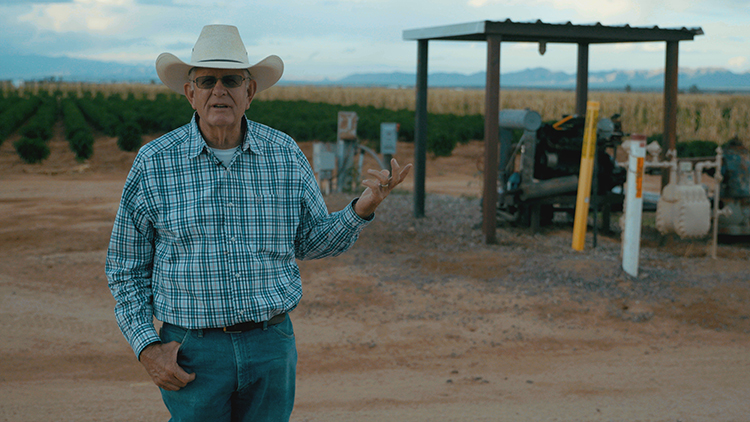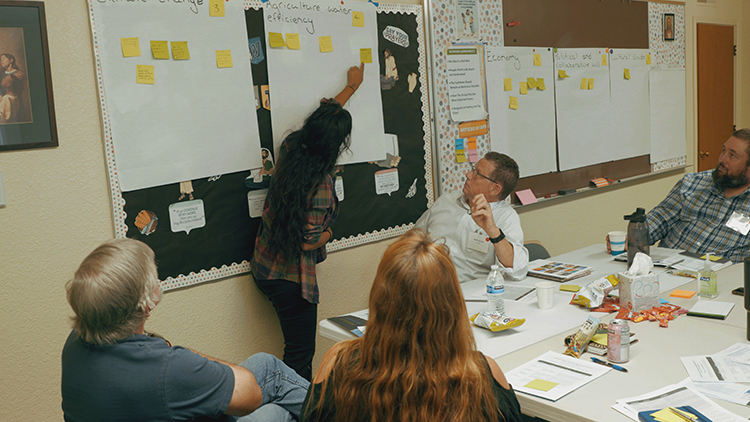
Supporting rural communities to protect their groundwater
Over forty years ago, Arizona took an important step toward long-term water security with the Groundwater Management Act. The Act focused on the state’s most populous areas, leaving rural groundwater largely unmanaged.
Today, however, protecting rural groundwater is one of Arizona’s top priorities, and one of its thorniest challenges.
The film Agriculture and Water in the West: A Community Takes Charge (trailer, full film), developed by the Babbitt Center for Land and Water Policy and the Lincoln Institute of Land Policy in partnership with the Arizona Water Innovation Initiative’s Impact Water-Arizona program, documents the work of one community to collaboratively address its groundwater issues after years of conflict.
“We have long championed innovative approaches to Arizona’s land and water needs because we’ve seen firsthand how entrenched conflict can become,” says Kristen Keener Busby, associate director for practice and partnerships at the Babbitt Center. “To support better water outcomes in the southwest, we put out a call for interested communities to contact us if they wanted to try a new approach, and that’s how we connected with folks in Sulphur Springs Valley.”
Using a workshop that came about through an extensive planning process with this Cochise County community as a jumping off point, the film provides insight into the groundwater challenges and potential solutions rural communities across the state are contending with. It also highlights the deep relationship people have with water.

Throughout the film, Sulphur Springs Valley residents refer to their wells as if they are beloved family members. Fifth generation rancher Tina Thompson speaks of the hand dug well that allowed her family to establish their ranch. Fourth generation grower Ed Curry describes one of his pumps as tired; it’s been slowing down after 50-60 years of service.
This close relationship with their wells makes sense. Ray Quay, a researcher with the Decision Center for a Desert City at ASU, says in the film, “Farming really didn’t become prevalent here until the invention of the groundwater pump.”
While some critique using scarce water to grow crops, the film, which was directed by Sean Ender, owner of Peak to Creek Films, addresses the issue head on.
“We farm in the desert, not in spite of the desert, but because of the desert. I think a lot of people have this idea of ‘why are you wasting water on agriculture in the desert’ and it's really the opposite,” says Paul Brierley, head of Arizona’s Department of Agriculture. “This is where water is going to be as highly productive as anywhere.”
Due in large part to that productivity, alongside a strong attachment to its culture and rich farming history, residents in the Sulphur Springs Valley are united in their desire to protect their groundwater, but have been divided on exactly how to do so. Susan Craig, director of Impact Water - Arizona, notes that the format of the workshop allowed the community to come together in a neutral space and listen to each other.

“This is a community that has been in deep conflict over water issues for a very long time,” says Ryan Maye Handy with the Lincoln Institute for Land Policy in one scene, “and they didn’t let that stop them from getting together, talking intimately about some of the least comfortable and maybe scariest topics they face every day.”
Even the presence of cameras didn’t seem to deter open and honest conversations.
“All of the discussions were so passionate that no one really had time to realize there were cameras recording them,” says Lara Van Lith, a graduate student researcher with Impact Water - Arizona. “The film conveys what it was like when these groups that had been at odds truly came together to really talk.”
Those conversations led to some surprising moments.
“One of the principles of one of the largest industrial agricultural operations stood at one of the white boards and said to me ‘we’re simply going to have to use less water,’” says Mark Spencer, a Valley resident, in the film. “To hear that was really encouraging.”
“It’s been fun to watch neighbors that were pitted against each other to come together in one room,” says Curry in one scene. “I went from not helping at all to being on the Governor’s Water Council and honored to be there and honored to be a part of the solution instead of part of the problem.”
The workshop was so successful that the group established a formal alliance to continue their work together.
“At the time this was filmed, the Sulphur Springs Water Alliance was still in the process of establishing itself and hiring a coordinator. They now have subcommittees, and a vision and mission,” says Craig. “Their goals include recharge and reduction, education and adaptation and commitment and representation. They feel strongly about responsible stewardship, consensus and an ongoing process that represents the interest of all community members and future generations.”
The film is already reaching well-beyond the participants.
“The closing statement about the need to understand uncertainty at a practical level and translating it into actionable steps really resonated with me,” Patty Emmert with Local First Arizona reflected. “I agree that the heightened levels of division we experience in various areas stem from the increased uncertainty we face daily. This highlights the importance of pausing, embracing difficult discussions and seeking consensus-based solutions.”
From the Governor’s office to the state legislature to rural residents, it is clear that addressing groundwater challenges is a priority for Arizona. These workshops are one important way to build consensus-based movement and empower local residents.
“While this kind of workshop will look different no matter where we do it because every place is unique,” says Van Lith, “it's going to have the same kind of collaborative process and outcomes between the community and water professionals to make a difference in places that otherwise wouldn't have the resources to do this on their own.”
Craig says that the ultimate hope is that this film will inspire other communities to take action on rural groundwater protection, and she has plans for more workshops in the coming year in collaboration with the University of Arizona and the Babbitt Center.
“It was a huge success to have a community come together and work to find common ground, and we are going to carry that success forward into new places facing related water challenges.”
Related resources
- Navigating uncertainty: Collaborative solutions for sustainable water management in the rural west
- Agriculture & Water in the West: A Community Takes Charge
- Arizona Forward recently recognized the project as a finalist for the Governor’s Award for Arizona’s Future at its annual Environmental Excellence Awards
- Sowing Seeds: How Scenario Planning Can Help Agricultural Communities Plan for a Resilient Future